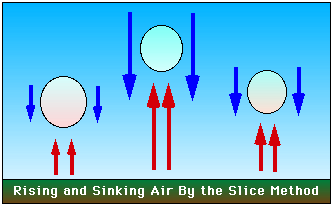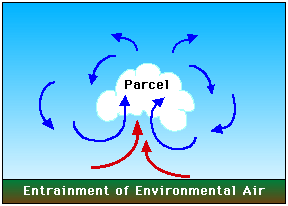However, the atmosphere is somewhat more complex. In reality, on the meso- and microscale, the atmosphere is rarely in hydrostatic equilibrium. Perhaps a heated parcel is located within a layer that experiences orographic lifting up a mountain side. In additon, the rising parcel displaces the air around and above it so that the environment near the rising parcel is not even static. Also, this non-static environmental air does mix with the rising air. Next, we will look at how these actions influence the stability of the atmosphere.
The Non-Static Environment
 As a parcel rises the air around and above it is displaced. The slice
method of lifting parcels to determine stability attempts to
compensate for the effects of the non-static environment. Though this
method has weaknesses of its own, a brief overview of this method does provide insight into how the displaced environmental air influences atmospheric stability. The slice method looks at a slice of the atmosphere with several saturated parcels rising through it. This method assumes that for every unit of mass being lifted, a unit of mass of environmental air is sinking. So, as the parcels are rising, air is sinking all around them. The air between the parcels, at a given point in time, is actually displaced air that has descended from above. Keep in mind, the rising parcels are saturated and, therefore, are cooling according to the moist adiabatic lapse rate. The descending environmental air is not saturated and is warming much faster according to the dry adiabatic lapse rate. The environmental air adjacent to a parcel is warmer than the air would be if the environment was static. By the equation of state, the environment should be in a state of equilibrium. As it descends, the environmental air warms in response to the pressure change. Here is the net effect of all of this motion. According to the slice method, there is not as much of a temperature difference between the parcel and the environment as there would be if the environment was static. This causes the parcel to be less buoyant than we might expect in
a static environment and thus reduces the amount of instability. In our
previous discussion in The Unstable
Atmosphere, instability is exaggerated. We will see next that the
entrainment of environmental air into a parcel of rising air also has the effect of reducing instability.
As a parcel rises the air around and above it is displaced. The slice
method of lifting parcels to determine stability attempts to
compensate for the effects of the non-static environment. Though this
method has weaknesses of its own, a brief overview of this method does provide insight into how the displaced environmental air influences atmospheric stability. The slice method looks at a slice of the atmosphere with several saturated parcels rising through it. This method assumes that for every unit of mass being lifted, a unit of mass of environmental air is sinking. So, as the parcels are rising, air is sinking all around them. The air between the parcels, at a given point in time, is actually displaced air that has descended from above. Keep in mind, the rising parcels are saturated and, therefore, are cooling according to the moist adiabatic lapse rate. The descending environmental air is not saturated and is warming much faster according to the dry adiabatic lapse rate. The environmental air adjacent to a parcel is warmer than the air would be if the environment was static. By the equation of state, the environment should be in a state of equilibrium. As it descends, the environmental air warms in response to the pressure change. Here is the net effect of all of this motion. According to the slice method, there is not as much of a temperature difference between the parcel and the environment as there would be if the environment was static. This causes the parcel to be less buoyant than we might expect in
a static environment and thus reduces the amount of instability. In our
previous discussion in The Unstable
Atmosphere, instability is exaggerated. We will see next that the
entrainment of environmental air into a parcel of rising air also has the effect of reducing instability.
Entrainment
 Not only is the environment in motion around rising air parcels, the
environment and the air parcels are not isolated from each other, as if
the parcel had an invisible skin surrounding it. The two do mix and
interact with each other. Based on the theories of hydrodynamics, a
current, or a jet, within a fluid, like the jet stream, draws or entrains
some of the surrounding fluid into itself. A cumulous cloud, which is a
saturated air parcel, is essentially a small jet, and likewise draws into
it some of the surrounding air. Because the surrounding air is dryer than
the parcel (i.e., the surrounding air is not saturated), as air is drawn
into the cloud, the mixing
ratio of the cloud decreases. The entrained dry air evaporates liquid
water within the cloud (produced by condensation) until the dry air too
becomes saturated. This process of evaporation has a cooling effect
within the cloud in much the same way our bodies cool off when water
evaporates from our skin. As the air temperature of the cloud decreases,
the cloud (or parcel) becomes less buoyant again reducing the amount of
instability.
Not only is the environment in motion around rising air parcels, the
environment and the air parcels are not isolated from each other, as if
the parcel had an invisible skin surrounding it. The two do mix and
interact with each other. Based on the theories of hydrodynamics, a
current, or a jet, within a fluid, like the jet stream, draws or entrains
some of the surrounding fluid into itself. A cumulous cloud, which is a
saturated air parcel, is essentially a small jet, and likewise draws into
it some of the surrounding air. Because the surrounding air is dryer than
the parcel (i.e., the surrounding air is not saturated), as air is drawn
into the cloud, the mixing
ratio of the cloud decreases. The entrained dry air evaporates liquid
water within the cloud (produced by condensation) until the dry air too
becomes saturated. This process of evaporation has a cooling effect
within the cloud in much the same way our bodies cool off when water
evaporates from our skin. As the air temperature of the cloud decreases,
the cloud (or parcel) becomes less buoyant again reducing the amount of
instability.
We must keep in mind when trying to determine atmospheric stability that neither of the methods we have discussed are perfect in their treatment of the atmosphere. Atmospheric motion is extremely complex, especially in the planetary boundary layer (PBL). The concepts outlined by these methods do, however, give us good insight into some of characteristics which are common to different conditions of stability, as well as some of the factors which influence stability in the atmosphere.
On to Focus on Air Quality
Back to Convective Instability: Lifting Entire Layers
 The Shodor
Education Foundation, Inc.
The Shodor
Education Foundation, Inc.Copyright © 1996